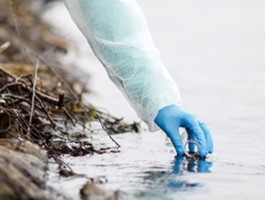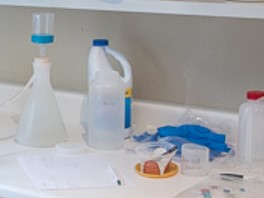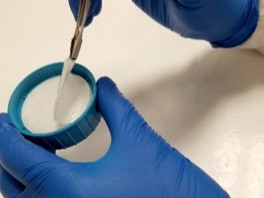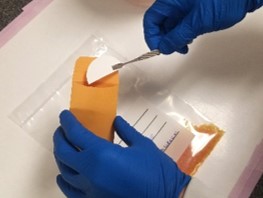Laboratory
Environmental DNA
Jan. 16 2023
Environmental DNA (eDNA) testing is a scientific tool available to augment or replace conventional ecological survey methods for the detection of species of management interest. eDNA refers to the genetic material (nuclear or mitochondrial DNA) that is released by an organism such as gametes, dead skin cells, feces, urine, mucous, etc. to its environment and can be collected from that environment using water or soil sampling.
The application of eDNA testing is particularly advantageous for aquatic and semi-aquatic species as DNA shed from the target organism is transported through the aquatic environment, improving the ability to detect the target species.
eDNA testing enables more informed decision-making about biodiversity and ecosystem health due to its enhanced sensitivity over conventional methods, which are time and labour intensive, subject to observer bias and limited in ability to confirm distribution for cryptic species or those with low population abundance.
Advantages of environmental DNA Testing
eDNA testing has several advantages when compared to conventional survey methods:
- Improved sensitivity – eDNA detects target species that are cryptic or present at low density with improved power of detection over conventional surveying.
- Time savings – reduced field time for sampling compared to conventional surveys.
- Cost effective – eDNA assays for multiple target species can be tested from a single collected sample.
- Less invasive – no need for trapping/electrofishing and reduced impact to sensitive habitats, including less risk of pathogen transfer.
- Permit and license not required – water sampling for eDNA with no requirement to trap, handle or even observe the target species.
- Reduced observer bias – simple environmental sam-pling reduces error associated with observer experience or variation in surveying efforts.
- Improved field safety – field sampling can occur during daylight hours and better weather conditions.
- Accurate – properly designed eDNA tests are specific to the target species not requiring a qualified expert in the field to identify the species.
- Retroactive testing – properly archived samples can be tested at a future date for additional species of interest.
- Expanded window of surveying – eDNA sampling can be completed outside of conventional restraints, e.g., window of amphibian calling.
environmental DNA Testing Protocol
Several methodologies for eDNA detection exist. Most methods utilize quantitative polymerase chain reaction (qPCR), also known as real-time PCR, to detect the presence of a target species. qPCR is a highly sensitive and specific DNA analysis that allows for detection of low quantities of DNA through cycles of PCR that exponentially generate many copies that are visualized by the lab instrument with a fluorescent reporter dye.
Given the nature of eDNA being low quantity, subject to variables in the environment and having a varied rate of release from the organism, eDNA assay results are qualitative (detect/non-detect) as opposed to quantitative.
Bureau Veritas has licensed the IntegritE-DNATM method from UVic Industry Partnerships, a technique developed by Dr. Caren Helbing [1] (Figure 1). The first step of this protocol is sample collection, filtration and preservation, assuring best eDNA recovery and conservation. The second step is the eDNA extraction from the sample collected. This protocol incorporates a quality check on the extracted eDNA as a third step in the form of an IntegritE-DNA™ qPCR assay to test for amplifiable eDNA extracted from the filtered water sample, but also absence of inhibitors. This is a critical step in preventing false negative eDNA results.
Figure 1: eDNA protocol at Bureau Veritas
| 1. Sample Collection, Filtration & Preservation | |
| For the best eDNA recovery, sample filtration and preservation (silica or 95 to 100% molecular grade ethanol) should take place within 24 hours of sample collection. | |
| 2. eDNA Extraction | |
| One quarter of the filter is extracted for eDNA testing. The remainder filter can be archived for future eDNA testing for the same species or new suspected species at site under study. | |
| 3. eDNA Quality Check | |
| IntegritE-DNA™ QC check for DNA quality is completed prior to testing for the target species. Only eDNA samples that successfully amplify IntegritE-DNA™ are carried forward for testing the target species. This minimizes the risk of false negatives due to poor DNA quality or qPCR inhibition. | |
| 4. Target Species qPCR Assay | |
| eDNA test for the target species. Some assays (e.g. eFish) test for multiple potential species (see table 1). Eight technical replicates are tested and reported for statistical confidence in detecting the target. |
The fourth step of this protocol is a species-specific eTarget qPCR assay and confirms the detection of target species DNA. Eight replicates are analyzed for each sample to provide sufficient statistical power to confirm detection or no detection of the target species. Positive controls are incorporated into this method to ensure testing performs as expected.
The volume of extracted eDNA is sufficient for four to five eTarget qPCR assays should multiple species detection from the same eDNA extract be required. This reduces overall cost by not requiring additional sampling, filtering, DNA extraction and integrity check if additional species are to be tested.
Sample Collection
Considering the variety of target species and their diverse habitat, there is substantial variation in methods for sample collection, filtration, preservation and processing (Figure 2).
Figure 2: Sample collection workflow
| 1. Water Collection | 2. Water Filtration | 3. Filter Preparation | 4. Preservation in Silica |
To maximize detection rates, considerable planning and preparation of the study design is key to a successful “in the field” collection protocol and expert consultation is advised.
Prior to any such consultation, we recommend a review of the detailed discussion presented in “Environmental DNA Protocol for Freshwater Aquatic Ecosystems, Version 2.2” [2].
eDNA preservation of the collected sample is important to ensure successful testing at the laboratory. As a rule, water samples should be filtered, preserved and stored in either silica or molecular grade ethanol (95 – 100 % molecular grade ethanol), or silica within 24 hours of collection (and prior to submission to the lab). Once preserved and stored, DNA in filters should remain viable for 6 months, or longer if stored in a non-self-defrosting freezer at -20ºC or below. Lab extracted eDNA (in a buffered solution) is most stable and will remain viable for years under these same freezer storage conditions.
Considerations for Your environmental DNA Study
To ensure effective application of eDNA testing, the following must be considered:
Field Sampling Design
- When to sample.
- Where to sample.
- Number of sample replicates – temporally and spatially.
Sample Filtration & Preservation
- Water sample should be filtered as soon as possible and within 24 hours of collection.
- Preserve filter in 95 - 100 % molecular grade ethanol or silica immediately following sample filtration.
eDNA Assay
- Specificity – eDNA assay validation needs to include verification that only the target species is detected.
- Lab protocol includes checks and controls to assess for DNA degradation and assay inhibition.
- Number of test replicates in the lab ensures sufficient statistical power (Bureau Veritas tests 8 replicates per sample).
Available environmental DNA Assays
Currently available eDNA assays are presented in Table 1. All of the listed assays are species-specific except the eFish assay. The eFish assay is a general test that identifies eDNA from 19 fish species (Table 1) but cannot distinguish between these fish species.
Table 1: Available eDNA Assays
| eDNA TEST | SPECIES | COMMON NAME | |
|---|---|---|---|
| Fish | ANRO | Anguilla rostrata | American Eel |
| Fish | CAAU | Carassius auratus | Goldfish |
| Fish | CACA | Catostomus catostomus | Salish Sucker |
| Fish | ESLU | Esox lucius | Northern pike |
| Fish | ESNI | Esox niger | Chain pickerel |
| Fish | HYPR | Hypomesus pretiosus | Surf Smelt |
| Fish | MIDO | Micropterus dolomieu | Smallmouth Bass |
| Fish | MISA | Micropterus salmoides | Largemouth bass |
| Fish | ONCL | Oncorhynchus clarkii | Cutthroat trout |
| Fish | ONGO | Oncorhynchus gorbuscha | Pink Salmon |
| Fish | ONKI | Oncorhynchus kisutch | Coho salmon |
| Fish | ONMY | Oncorhynchus mykiss | Rainbow trout (Steelhead trout) |
| Fish | ONNE | Oncorhynchus nerka | Sockeye salmon |
| Fish | ONTS | Oncorhynchus tshawytscha | Chinook salmon |
| Fish | RHUM | Rhinichthys umatilla | Umatilla Dace |
| Fish | SACO | Salvelinus confluentus | Bull trout |
| Fish | THAR | Thymallus arcticus | Arctic grayling |
| Fish | THPA | Thaleichthys pacificus | Eulachon |
| Fish | eFish* | Anguilla rostrata (ANRO) | American eel |
| Fish | eFish* | Cottus cognatus (COCO) | Slimy sculpin |
| Fish | eFish* | Esox lucius (ESLU) | Northern pike |
| Fish | eFish* | Gasterosteus aculeatus | Three-spined stickleback |
| Fish | eFish* | Micropterus dolomieu (MIDO) | Smallmouth bass |
| Fish | eFish* | Micropterus salmoides (MISA) | Largemouth bass |
| Fish | eFish* | Oncorhynchus clarkii (ONCL) | Cutthroat trout |
| Fish | eFish* | Oncorhynchus gorbuscha (ONGO) | Pink salmon |
| Fish | eFish* | Oncorhynchus keta (ONKE) | Chum salmon |
| Fish | eFish* | Oncorhynchus kisutch (ONKI) | Coho salmon |
| Fish | eFish* | Oncorhynchus mykiss (ONMY) | Rainbow trout |
| Fish | eFish* | Oncorhynchus nerka (ONNE) | Sockeye salmon |
| Fish | eFish* | Oncorhynchus tshawytscha (ONTS) | Chinook salmon |
| Fish | eFish* | Prosopium cylindraceum (PRCY) | Round whitefish |
| Fish | eFish* | Salvelinus confluentus (SACO) | Bull trout |
| Fish | eFish* | Salvelinus malma (SAMA) | Dolly varden |
| Fish | eFish* | Salmo salar (SASA) | Atlantic salmon |
| Fish | eFish* | Thymallus arcticus (THAR) | Arctic grayling |
| Fish | eFish* | Thaleichthys pacificus (THPA) | Eulachon |
| Frog | ANBO | Anaxyrus (Bufo) boreas | Western toad |
| Frog | ASMO | Ascaphus montanus | Rocky mountain tailed frog |
| Frog | ASTR | Ascaphus truei | Pacific (Coastal) tailed frog |
| Frog | LICA | Lithobates (Rana) catesbeiana | North American bullfrog |
| Frog | LIPI | Lithobates (Rana) pipiens | Northern leopard frog |
| Frog | RAAU | Rana aurora | Northern red-legged frog |
| Frog | RACA | Rana cascadae | Cascades frog |
| Frog | RALU | Rana luteiventris | Columbia spotted frog |
| Frog | RAPR | Rana pretiosa | Oregon spotted frog |
| Frog | SPIN | Spea intermontana | Great Basin spadefoot |
| Other | AMMV (AMTI) | Ambystoma mavortium | Blotched tiger salamander |
| Other | AMMV (AMTI) | Ambystoma tigrinum | Tiger salamander |
| Other | COTE | Contia tenuis | Sharp-tailed Snake |
| Other | GLIN | Glyptemys insculpta | Wood turtle |
| Other | SOBE | Sorex bendirii | Pacific water shrew |
*The eFish assay is designed to be non-specific. It may detect eDNA from other fish species in addition or instead of the specific species listed here, which the assay has been validated for. It is important to note that in effort to design the eDNA assay to detect presence of any fish species, the assay also detects presence of some amphibian species.
environmental DNA Assay Development
To date, Bureau Veritas’ approach to eDNA assay development for commercial applications has been in-house (re)validation of previously published/documented methods. This ensures assay transferability for laboratory-controlled and field-derived samples regarding two crucial parameters: sensitivity (reliable detection criteria) and specificity (no cross-reaction, especially for closely related or sympatric species). Through client feedback, Bureau Veritas will continue to expand the suite of commercially available eDNA assays presented in Table 1.
It should be noted, however, that the above approach leaves an important, unanswered question. What do we do for target species where no eDNA assay has been developed?
Future availability of DNA sequence data for additional species will undoubtedly allow for primer and probe design. However, a prerequisite to functional assay design, which is the availability of tissue samples (or total DNA) from target species (and closely-related species or sympatric species), presents substantial difficulty for low density/rare species and could be prohibitive for endangered species. Bureau Veritas intends to establish third party, collaborative agreements that will facilitate the development of novel eDNA assays for target species of interest.
Limitations of environmental DNA Testing
eDNA testing has limitations that should be considered when designing the field survey and interpreting laboratory results:
- Binary results - eDNA testing provides a detected or not detected result. Results cannot be extrapolated to determine abundance or density of the target species.
- Limits to geographical information – since eDNA is transported in an aquatic environment, it cannot provide exact detail on the proximity of the organism or duration in the environment.
- eDNA does not confirm presence of a living organism, but rather detection of DNA from the target species.
- Source of DNA (e.g., gametes vs. skin) is not revealed by eDNA.
- Results are limited to detect or not detect - the age, gender, size, or reproductive status of the organism is not revealed.
- Subject to environmental variability for movement of DNA (water flow rate) and stability (water temperature, pH, salinity, exposure to microbes and ultraviolet light, which degrade DNA). Typically, eDNA can be detected 7 to 21 days after being released to the environment.
Moving Forward
eDNA testing is quickly becoming a reliable and robust technique that complements traditional environmental monitoring. It should be recognized that traditional survey techniques still have select advantages to eDNA testing, the most relevant of which may be their ability to distinguish live species and the different life stages of those species. Further, standards for eDNA testing across laboratories are not yet established but need to be carefully considered to create maximum utility of this evolving technique.
Bureau Veritas is proud to be the first laboratory in Canada accredited for eDNA testing by the Standards Council of Canada to rigorous ISO 17025 standards. We are committed to working closely with the eDNA community to develop consensus-based standards that will enable better interpretations of eDNA results.
References
[1] Veldhoen N, Hobbs J, Ikonomou G, Hii M, Lesperance M, and Helbing CC. Implementation of Novel Design Features for qPCR-Based eDNA Assessment. PLoS One. 2016; 11(11): e0164907. Published 2016 Nov 1. DOI:10.1371/journal.pone.0164907
[2] Jared Hobbs and Caren Goldberg. Environmental DNA Protocol for Freshwater Aquatic Ecosystems (Version 2.2). Prepared for: BC Ministry of Environment. November 2017



